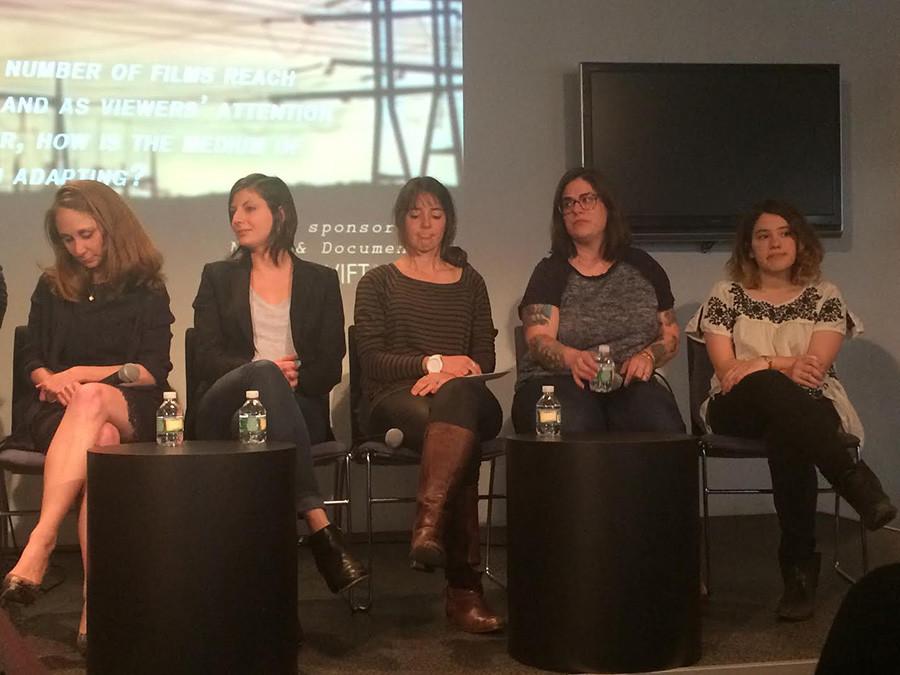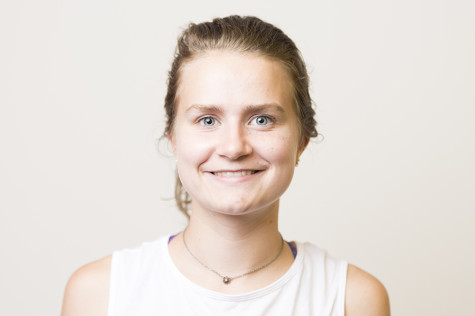Panelists look at video journalism
Kyra Darton, Kasia Cieplak-Mayr von Baldegg, Mariana Keller, Lauren Cynamon and Emma Dessau, left to right.
April 28, 2015
The Internet is widely considered to have shortened the attention span of viewers, which panelists at an event on the evolution of documentary journalism Monday evening said can encourage journalists and producers to make more interesting content.
The panel held at the Arthur L. Carter Journalism Institute, hosted by New York Women in Film and Television and titled Streaming Stories: Short Docs for the Web, was moderated by Veena Rao and featured eight speakers from the journalism industry — Kasia Cieplak-Mayr von Baldegg, Lauren Cynamon, Kyra Darto, Emma Dessau, Kelsey Doyle, Mariana Keller, Kathleen Lingo and Jason Sondhi.
Cieplak-Mayr von Baldegg, executive producer of The Atlantic’s videos, explained why Internet users tend to prefer shorter content.
“When you have someone’s attention in theater or TV, you have a block of time that they’ve already committed to your project,” Cieplak-Mayr von Baldegg said. “They are coming in good faith that you will have something to offer them whereas when you encounter work online your audience is ready to leave in five seconds.”
Cieplak-Mayr von Baldegg described what it takes to keep a viewer interested through the whole piece.
“My theory of web video is — it demands intensity,” Cieplak-Mayr von Baldegg said. “It demands intensity of ideas and quality visual storytelling — a quirkiness and originality that will grab people right away. Whereas, in theater or on TV, you can really take your time and sort of weave a long, slow, beautiful narrative.”
Exciting does not always mean an adrenaline rush, however, as Sondhi, the senior manager of curation at Vimeo, suggested.
“You don’t need to have a hold where you’re just dropping someone into an exciting situation,” Sondhi said. “But there needs to be something about the presentation and that’s the thumbnail, the description, the subject, the headline that gets immediate attention. There’s got to be an immediate focus, otherwise you won’t get the initial click.”
Darton, executive producer at Retro Report, said there’s still room for more traditional newsmakers and documentarians in the newer, shorter format world. Darton explained that traditionalists from news and documentaries work together at Retro Report.
“A lot of our producers have a much stronger news background and come from like Frontline or 60 Minutes, but our editors are really more traditional documentary film editors,” Darton said. “I think it’s that combination that push-pulls in between news and documentary that really works well.”
Caitlin Nagle, who is the executive director of the Made in New York Media Center by Independent Filmmaker Project, said she attended the event because it offered a unique insight into a field she is already involved in.
“The thing I enjoyed most was how much everyone on the panel enjoyed each others work,” Nagle said. “That they’re all actually fans of each others’ work, and they could speak to different parts of each others’ work that they liked the most.”
A version of this article appeared in the Tuesday, April 28 print edition. Email Justine Morris at [email protected].

























































































































































